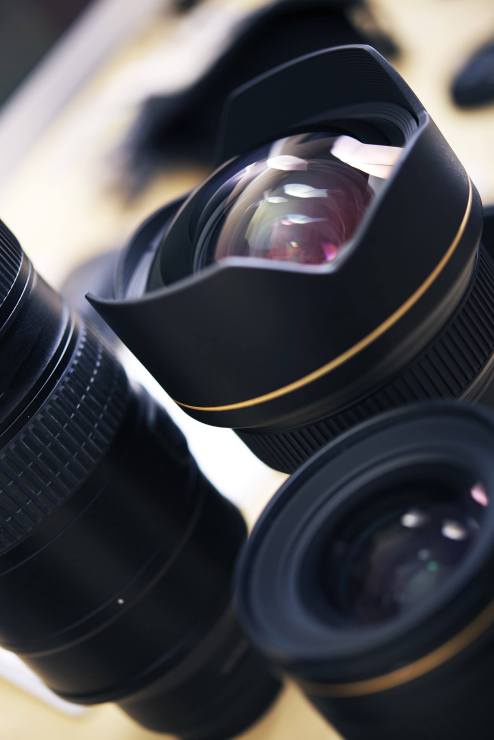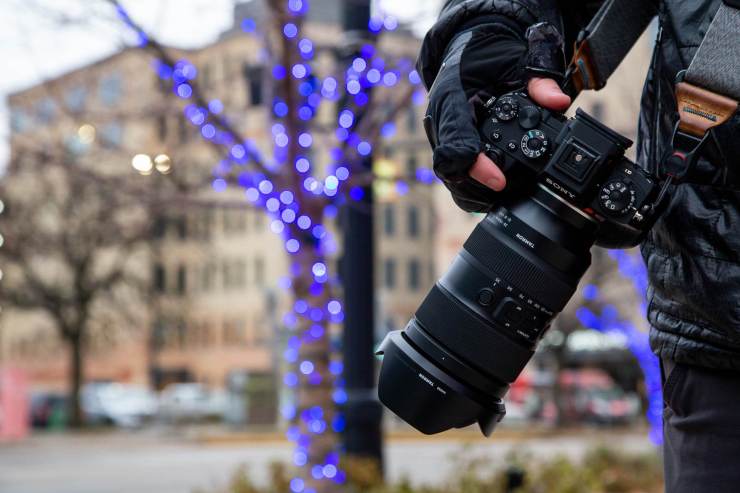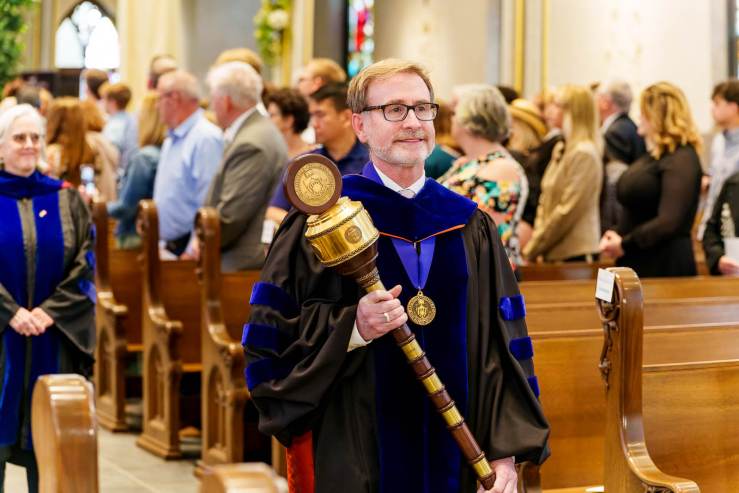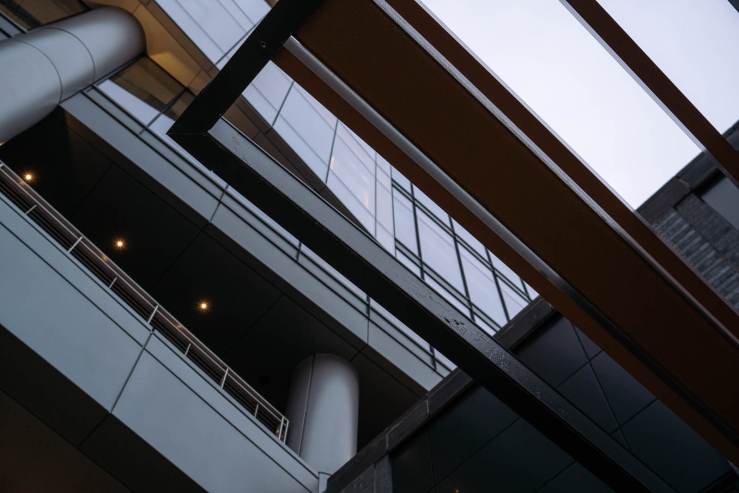For many photographers, the “lens trinity” is a necessary evil. We’re taught that when we’re first starting out as a photographer — whether we’re shooting events, weddings, portraits or other subjects — that having a wide-angle, standard and telephoto zoom lens is necessary for our bag.
I’m guilty of this myself, as these were the first three lenses I purchased when I got into photography. With each system change, I continued to buy them. And rightfully so — I used them a ton. They helped me develop my event skillset.
But with Tamron’s recent 35-150mm f/2-2.8 lens for Sony E-mount, it has me questioning: Is it time to be done with the idea of having a lens trinity?
What’s the lens trinity?

The lens trinity is traditionally what photographers call the combination of wide, standard and telephoto zoom lenses. It’s usually something like a 14-24mm, 24-70mm and 70-200mm.
This group of lenses let photographers — specifically those that photograph events — capture all of the different angles of a scene. You could get a wide view of a room, with all the attendees. You could take group photographs easily. And then you could capture speakers from afar.
These lenses also usually have a maximum aperture of f/2.8, making them great in low-light situations.
Downsides to the trinity
The most common thing you’ll hear from photographers about the trinity is that it’s simply boring. It doesn’t provide a creative, artistic view. It captures the scene in front of you well, but if you want to do anything beyond that … well, you might need to pick up something with a bit more character.
This led photographers to picking up something like a 50mm f/1.4 prime lens, which allowed for greater background separation.
The other downside is that you either constantly have to switch back and forth between lenses, or you need to carry multiple camera bodies. With a fast-moving event, switching lenses isn’t realistic. But at an 8-hour event, having two cameras slinging over your shoulders isn’t exactly comfortable, either.
Enter the Tamron 35-150mm f/2-2.8 lens

While I originally tested the Tamron 35-150mm f/2-2.8 back in December 2021, I recently had a chance to check it out again. I used this lens constantly, for everything from events to landscapes and everything in-between.
I was initially a bit concerned as to whether I would miss any of my focal range from the standard and telephoto lenses I’m used to using. Up until recently, I had used the Tamron 28-75mm f/2.8 G2 lens, along with the Tamron 70-180mm f/2.8. Mainly, I was concerned I would “miss” those extra 30mm on the telephoto end of things.
.mgl-tiles { display: none; } #mgl-gallery-634ec652b7948 { margin: -5px; width: calc(100% + 10px); } #mgl-gallery-634ec652b7948 .mgl-box { padding: 5px; } @media screen and (max-width: 768px) { #mgl-gallery-634ec652b7948 { margin: -5px; width: calc(100% + 10px); } #mgl-gallery-634ec652b7948 .mgl-box { padding: 5px; } } @media screen and (max-width: 460px) { #mgl-gallery-634ec652b7948 { margin: -5px; width: calc(100% + 10px); } #mgl-gallery-634ec652b7948 .mgl-box { padding: 5px; } }





I quickly realized that I could get away with not having that extra 30mm. Having a 32-megapixel sensor in the Sony a7 IV meant I could easily crop in on my subjects without any major loss of detail. The sharpness of the lens was simply profound, and the depth of field? Stunning, especially for a zoom lens. It also provided me with a bit more freedom while post-processing, and allowed me to look at the overall scene more.
While the 35-150mm obviously won’t fill the need for a wide-angle zoom lens, it has the potential to fill the need for the other two lenses of the trinity.
Other things to keep in mind
.mgl-tiles { display: none; } #mgl-gallery-634ec652b8f3a { margin: -5px; width: calc(100% + 10px); } #mgl-gallery-634ec652b8f3a .mgl-box { padding: 5px; } @media screen and (max-width: 768px) { #mgl-gallery-634ec652b8f3a { margin: -5px; width: calc(100% + 10px); } #mgl-gallery-634ec652b8f3a .mgl-box { padding: 5px; } } @media screen and (max-width: 460px) { #mgl-gallery-634ec652b8f3a { margin: -5px; width: calc(100% + 10px); } #mgl-gallery-634ec652b8f3a .mgl-box { padding: 5px; } }






Outside of focal range, I did have a few other minor concerns. The main one being whether or not I could use a heavier lens for a long event without getting any fatigue. After all, the Tamron 35-150mm is quite a bit heavier than the 28-75mm and 70-180mm.
While I found myself initially building up a callus on one of my fingers, this went away after using the lens for a couple photoshoots. It became more comfortable to hold, and I learned how to use it with more weight coming from my left hand (which went under the lens) as opposed to my right hand doing the lifting. I didn’t have to think about this — it came naturally after a short period.
The other thing I learned was that for some group shots, I had to step back just a bit further than I would have with my 28-75mm. This was by no means a deal-breaker, and it actually helped me better compose my shot because I wasn’t so close up physically.
It’s time for the trinity to give way to a new breed of lenses
.mgl-tiles { display: none; } #mgl-gallery-634ec652ba3a0 { margin: -5px; width: calc(100% + 10px); } #mgl-gallery-634ec652ba3a0 .mgl-box { padding: 5px; } @media screen and (max-width: 768px) { #mgl-gallery-634ec652ba3a0 { margin: -5px; width: calc(100% + 10px); } #mgl-gallery-634ec652ba3a0 .mgl-box { padding: 5px; } } @media screen and (max-width: 460px) { #mgl-gallery-634ec652ba3a0 { margin: -5px; width: calc(100% + 10px); } #mgl-gallery-634ec652ba3a0 .mgl-box { padding: 5px; } }




I remember when Tamron first introduced its 15-30mm f/2.8 wide-angle for DSLR cameras. I considered this to be a truly groundbreaking lens. I think the same way of Tamron’s latest 35-150mm f/2-2.8 lens. There’s nothing else like it. And in a world where mirrorless lenses often have a hard time pushing boundaries … it’s nice to see something fresh with picture quality that is second to none.
Get ready for summer with a Tamron lens!
We’ve teamed up with Tamron to give away a Tamron zoom lens! With their dynamic zoom lenses, you can capture a wide-angle landscape or a street scene from afar with ease. No matter what your summer plans are, these weather-sealed lenses will be able to follow you whatever the weather. Hurry; this contest ends June 24, 2022!
Tell your story with the second annual Visual Storytelling Conference!
Experience four days of interactive, online training sessions featuring a range of educational content with experienced photographers and content creators. This free event kicks off with a series of technical boot camps to build essential skills, followed by live, online sessions on photography, video, business and social media. Join live from March 10-13, 2022!
